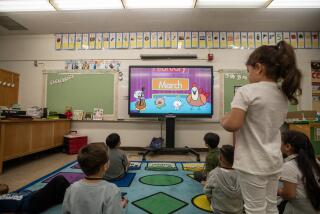Shake It Up Baby . . . Now, Twist and Shout!
- Share via
While watching a TV music awards show, 9-month-old Nia Harrill mimicked the tunes sung by each performer. Vanessa and Donald Harrill of Lomita say they watched in amazement as their firstborn picked up the new sounds and musical rhythms, and can only guess that she is learning quickly because she has been exposed to music at an early age.
For five Saturdays in the fall, the Harrills took their daughter to Cal State Dominguez Hills in Carson where the whole family enrolled in “Music for Mothers and Babies,” a new 30-minute class that teaches parents how to use music and movement to stimulate their child’s senses.
“It’s really neat watching her learn new sounds and watching her imitate things,” Vanessa Harrill says. “Besides, we thought this would be something really nice for us to do as a family.”
Under the guidance of veteran music teacher Cecilia Riddell, parents are exposed to a wide variety of songs and dances that they can engage their kids in at home. “Their transformation is like night and day,” says Riddell of her students. “By the end of class they gain so much confidence and independence.”
The capacity for tots to learn new sounds, songs, movements and rhythms seems limitless. One class starts off with a country and western waltz, goes to a Latin number, and concludes with a Mozart concerto and massage for the babies, who take the pampering with a bottle.
Child psychologist Mary O’Connor, director of the UCLA Infant and Preschool Service, says studies on the impact of music on babies and children have shown that music and dance improve early childhood development because both allow babies to use and integrate their senses.
When “Waltzing With Bears” echoes over the sound system in Riddell’s classroom, each mom holds her baby in the traditional waltz position. As the lullaby-like song plays, they waltz in a circle while swishing colorful scarves.
Then the babies, who range in age from 6 to 10 months, lie on mats while their parents sing a series of rhymes. Riddell demonstrates a short ditty “Crisscross Apple Sauce” for the mothers to sing as they stroke their fingers across their babies’ backs in the shape of an X.
Next, castanets and finger puppets are passed out for the babies to shake, though younger students prefer to suck on them. Latin music plays and the families all get up to dance again.
Gabriela Flores of Bell beams as her son, Oscar, bobs his head to the rhythm. “One of the reasons I took this class is because I wanted to see how babies make music,” she says.
O’Connor says that classes like Riddell’s are difficult to find but that they have a positive effect on children. “The positive interaction makes the baby feel more secure and frees the child to be more secure to learn other things,” she says.
As her class breaks up for the day, Riddell, who has taught a music and movement class for 10 years and added the baby class in October, tells parents that the most important lesson they can get from this class is to use their voices as often as they can.
“The best music to your babies ears is the music you make with your own voice,” says Riddell, who has been a music educator for 25 years. “No matter what you think of your singing abilities, it’s you that your baby wants to hear.”
* The next five-week session of “Music for Mothers and Babies” begins March 29. Classes are $6 per week. For more information, call (310) 243-3543.
More to Read
The biggest entertainment stories
Get our big stories about Hollywood, film, television, music, arts, culture and more right in your inbox as soon as they publish.
You may occasionally receive promotional content from the Los Angeles Times.










